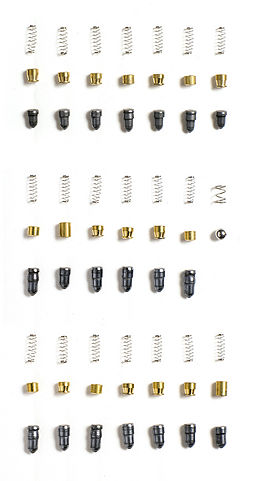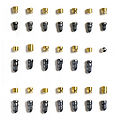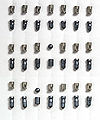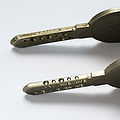High pin count: Difference between revisions
(New page for High Pin Count locks) |
m (add kaba to list) |
||
| Line 15: | Line 15: | ||
* [[Australian Lock Company|BiLock]] | * [[Australian Lock Company|BiLock]] | ||
* [[Goal]] | * [[Goal]] | ||
* [[KABA]] | |||
* [[MIWA]] | * [[MIWA]] | ||
* [[WEST]] | * [[WEST]] | ||
Revision as of 18:42, 12 December 2022
High pin count

High pin count locks are locks that have a large number of pins in the cylinder, which make it more difficult to pick or manipulate the lock without the proper key. These pins work together to create a unique key code that is difficult to duplicate, providing enhanced security for the lock. This type of lock is often used in high security applications, such as commercial or government buildings, to provide additional protection against unauthorized access.
High pin count locks generally have 8 or more pins. Some complex high pin count locks have 20 pins or more, arranged in two or more rows within the lock. Traditional pin-tumbler locks are difficult to manufacture and become less reliable with such high pin counts. Dimple keys are often utilized to lift pins to the shear line across multiple rows. Other approaches to high pin count design include combinations of multiple component types, such as a row of pin-tumbler pin stacks combined with an auxiliary sidebar to further resist picking and manipulation.
High pin count locks are commonly used on commercial and high-security doors and are considered more secure than traditional lock designs with fewer pins. The main goal of all high security locks is not to be undefeatable, but instead to make defeat too expensive or time consuming to be feasible.
Companies that are well-known for their high pin count locks include:
Gallery
Dimple cuts in a WEST 917 key
20 pin setup from a WEST 917
21 pin GOAL V18 key
19 active pins in a Goal V18
Dimple cuts in a Kaba experT key
Nine dimple cuts in a Goal D9 key
Kale Kilit 164 BNE - pins
High pin count lock listing
- ABUS EC700
- ASSA Twin Combi
- BiLock FG
- Goal D9
- Goal V18
- Kale Kilit 164 BNE
- MIWA 3800
- MIWA EC
- WEST 916
- WEST 917
See also
| This article is a stub. You can help Lockwiki by expanding it. |








